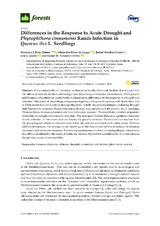Differences in the Response to Acute Drought and Phytophthora cinnamomi Rands Infection in Quercus ilex L. Seedlings
Autor
Ruiz Gómez, Francisco
Pérez de Luque, A.
Sánchez-Cuesta, Rafael
Quero, José L.
Navarro Cerrillo, Rafael M.
Editor
MDPIFecha
2018Materia
Biomass allocationDehesas
Drought
Montados
Oak decline
Plant traits
Root rot
METS:
Mostrar el registro METSPREMIS:
Mostrar el registro PREMISMetadatos
Mostrar el registro completo del ítemResumen
The sustainability of “dehesas” is threatened by the Holm oak decline. It is thought that
the effects of root rot on plant physiology vary depending on external stress factors. Plant growth
and biomass allocation are useful tools to characterize differences in the response to drought and
infection. The study of physiological responses together with growth patterns will clarify how and
to what extent root rot is able to damage the plant. A fully factorial experiment, including drought
and Phytophtora cinnamomi Rands infection as factors, was carried out with Quercus ilex L. seedlings.
Photosynthesis, biomass allocation and root traits were assessed. Photosynthetic variables responded
differently to drought and infection over time. The root mass fraction showed a significant reduction
due to infection. P. cinnamomi root rot altered the growth patterns. Plants could not recover from
the physiological effects of infection only when the root rot coincided with water stress. Without
additional stressors, the strategy of our seedlings in the face of root rot was to reduce the biomass
increment and reallocate resources. Underlying mechanisms involved in plant-pathogen interactions
should be considered in the study of holm oak decline, beyond the consideration of water stress as
the primary cause of tree mortality.

